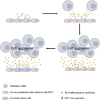Therapeutic Effects of Natural Products on Cervical Cancer: Based on Inflammatory Pathways
- PMID: 35645817
- PMCID: PMC9136176
- DOI: 10.3389/fphar.2022.899208
Therapeutic Effects of Natural Products on Cervical Cancer: Based on Inflammatory Pathways
Abstract
Inflammation is a protective response of the body to an irritant. When an inflammatory response occurs, immune cells are recruited to the injury, eliminating the irritation. The excessive inflammatory response can cause harm to the organism. Inflammation has been found to contribute to cervical cancer if there is a problem with the regulation of inflammatory response. Cervical cancer is one of the most common malignant tumors globally, and the incidence tends to be younger. The harm of cervical cancer cannot be ignored. The standard treatments for cervical cancer include surgery, radiotherapy and chemotherapy. However, the prognosis for this treatment is poor, so it is urgent to find a safer and more effective treatment. Natural products are considered excellent candidates for the treatment of cervical cancer. In this review, we first describe the mechanisms by which inflammation induces cervical cancer. Subsequently, we highlight natural products that can treat cervical cancer through inflammatory pathways. We also introduce natural products for the treatment of cervical cancer in clinical trials. Finally, methods to improve the anticancer properties of natural products were added, and the development status of natural products was discussed.
Keywords: HPV; cervical cancer; inflammatory; natural products; therapeutic.
Copyright © 2022 Zhou, Long, Xu, Li, Cheng, Luo and Gao.
Conflict of interest statement
The authors declare that the research was conducted in the absence of any commercial or financial relationships that could be construed as a potential conflict of interest.
Figures



References
Publication types
LinkOut - more resources
Full Text Sources

